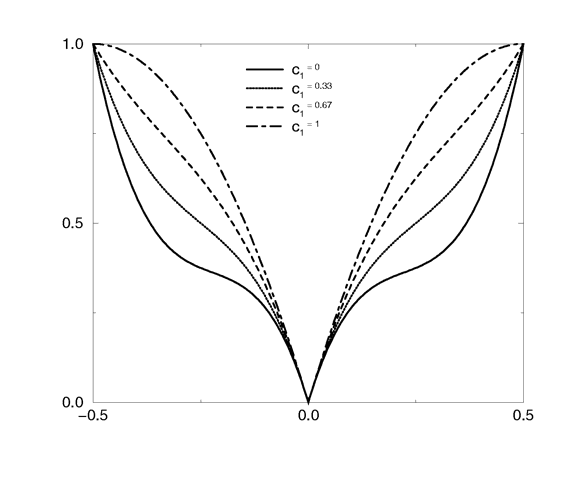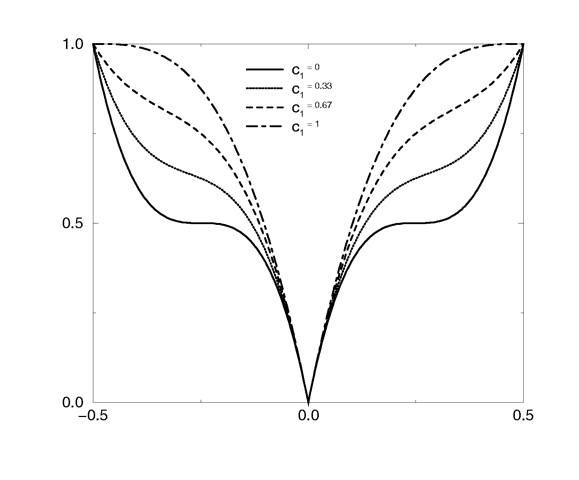Section 7.6.7.14
Marble
This blends from yellow to cyan and then it abruptly changes back to yellow and repeats. However replacing gradient x with marble smoothly blends from yellow to cyan as the x coordinate goes from 0.0 to 0.5 and then smoothly blends back from cyan to yellow by x=1.0.
Earlier versions of POV-Ray did not allow you to change wave types. Now that wave types can be changed for most any pattern, the distinction between marble and gradient x is only a matter of default wave types.
When used with turbulence and an appropriate color map, this pattern looks like veins of color of real marble, jade or other types of stone. By default, marble has no turbulence.
The pattern may be used with color_map, pigment_map, normal_map, slope_map and texture_map.
The pattern uses the ramp_wave wave type by default but may use any wave type. The pattern may be used with color_map, pigment_map, normal_map, slope_map and texture_map.
When used as a normal pattern it uses a specialized normal perturbation function. This means that the quilted pattern cannot be used with normal map, slope map or wave type modifiers in a normal statement.
When used as a pigment pattern or texture pattern, the quilted pattern is similar to normal quilted but is not identical as are most normals when compared to pigments. When used in pigment or texture statements the quilted pattern uses the ramp_wave wave type by default but may use any wave type. The pattern may be used with color_map, pigment_map and texture_map.
The two parameters control0 and control1 are used to adjust the curvature of the seam or gouge area between the quilts. The syntax is:
The values should generally be kept to around the 0.0 to 1.0 range. The default value is 1.0 if none is specified. Think of this gouge between the tiles in cross-section as a sloped line.
This straight slope can be made to curve by adjusting the two control values. The control values adjust the slope at the top and bottom of the curve. A control values of 0 at both ends will give a linear slope, as shown above, yielding a hard edge. A control value of 1 at both ends will give an "s" shaped curve, resulting in a softer, more rounded edge.
The pattern uses the ramp_wave wave type by default but may use any wave type. The pattern may be used with color_map, pigment_map, normal_map, slope_map and texture_map.
Usually the ripples from any given center are about 1 unit apart. The frequency keyword changes the spacing between ripples. The phase keyword can be used to move the ripples outwards for realistic animation.
The number of ripple centers can be changed with the global parameter global_settings { number_of_waves FLOAT } somewhere in the scene. This affects the entire scene. You cannot change the number of wave centers on individual patterns. See section "Number_Of_Waves" for details.
When used as a normal pattern, ripples uses a specialized normal perturbation function. This means that the ripples pattern cannot be used with normal map, slope map or wave type modifiers in a normal statement.
When used in pigment or texture statements the ripples pattern uses the ramp_wave wave type by default but may use any wave type. The pattern may be used with color_map, pigment_map and texture_map.
The NUMBER_OF_ARMS value determines how may arms are winding around the y-axis.
The pattern uses the triangle_wave wave type by default but may use any wave type. The pattern may be used with color_map, pigment_map, normal_map, slope_map and texture_map.
The pattern uses the triangle_wave wave type by default but may use any wave type. The pattern may be used with color_map, pigment_map, normal_map, slope_map and texture_map.
Usually the waves from any given center are about 1 unit apart. The frequency keyword changes the spacing between waves. The phase keyword can be used to move the waves outwards for realistic animation.
The number of ripple centers can be changed with the global parameter global_settings { number_of_waves FLOAT } somewhere in the scene. This affects the entire scene. You cannot change the number of wave centers on individual patterns. See section "Number_Of_Waves" for details.
When used as a normal pattern, waves uses a specialized normal perturbation function. This means that the waves pattern cannot be used with normal map, slope map or wave type modifiers in a normal statement.
When used in pigment or texture statements the waves pattern uses the ramp_wave wave type by default but may use any wave type. The pattern may be used with color_map, pigment_map and texture_map.
Section 7.6.7.15
Onion
Section 7.6.7.16
Quilted
Quilted pattern with c0=0 and different values for c1.

Quilted pattern with c0=0.33 and different values for c1.

Quilted pattern with c0=0.67 and different values for c1.

Quilted pattern with c0=1 and different values for c1.
Section 7.6.7.17
Radial
Section 7.6.7.18
Ripples
Section 7.6.7.19
Spiral1
Section 7.6.7.20
Spiral2
Section 7.6.7.21
Spotted
Section 7.6.7.22
Waves
Table Of Contents